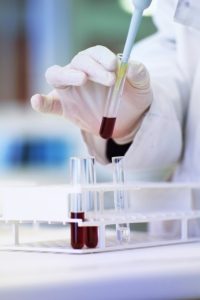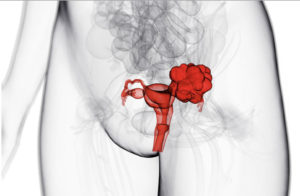Endometrial Cancer Specimens
Bay Biosciences provides fresh frozen (-80C) high quality, clinical grade tumor tissue specimens with matching fresh frozen sera (serum), plasma and peripheral blood mononuclear cells (PBMC) biofluid samples. The biofluid samples are processed from patient’s whole-blood from unique treatment-naive Endometrial cancer (Endometrial Carcinoma or Uterine cancer) patients.
Endometrial Cancer Overview
Endometrial cancer is a type of gynecological cancer that starts from the Endometrium which is the lining of the uterus or the womb. The uterus is the hollow, pear-shaped pelvic organ where fetal development occurs. Endometrial cancer is also known as uterine cancer. It is the result of the abnormal growth of cells that have the ability to invade or spread to other parts of the body. The mutation turns normal healthy cells into abnormal cells. Healthy cells grow and multiply at a set rate, eventually dying at a set time. Abnormal cells grow and multiply out of control, and they don’t die at a set time. The accumulating abnormal cells form a mass or a tumor. Cancer cells invade or metastasize nearby tissues and can separate from an initial tumor to spread elsewhere in the body.
According to the National Cancer Institute over 65000 uterine cancer cases are estimated or total of 3.6% of total cancer cases in the United States. More than 80 percent of patients with uterine cancer survive for five years or longer after receiving the diagnosis.
The signs and symptoms are mostly vaginal bleeding (not associated with menstrual period, pelvic pain, bleeding between periods, pain with urination, pain during sex. Endometrial cancer occurs mostly after the menopause.
There are several factors that increase the risk of Endometrial cancer which include changes in the balance of female hormones in the body. The ovaries make tow main hormones, estrogen and progesterone, fluctuations in the balance of these hormones causes changes in the endometrium. A disease or condition that increases the amount of estrogen but not at the level of progesterone in the body can increase the risk of endometrial cancer. In addition women who starts menstruation at the early age, women who have never been pregnant, older age, obesity, hormone therapy, breast cancer increases the risk of Endometrial cancer.
Signs and Symptoms of Endometrial Cancer
The most common symptom of endometrial cancer is abnormal vaginal bleeding.
This can include:
- Changes in the length or heaviness of menstrual periods
- Vaginal bleeding or spotting between menstrual periods
- Vaginal bleeding after menopause
Other potential symptoms of endometrial cancer include:
Abnormal vaginal bleeding is often caused by menopause or other non-cancerous conditions. But in some cases, it’s a sign of endometrial cancer or other types of gynecological cancer.
Stages of Endometrial Cancer
Over time, endometrial cancer can potentially spread from the uterus to other parts of the body.
Endometrial cancer is classified into four stages based on how much it has grown or spread:
- Stage 1: The cancer is only present in the uterus.
- Stage 2: The cancer is present in the uterus and cervix.
- Stage 3: The cancer has spread outside the uterus, but not as far as the rectum or bladder. It might be present in the fallopian tubes, ovaries, vagina and nearby lymph nodes.
- Stage 4: The cancer has spread beyond the pelvic area. It might be present in the bladder, rectum, and distant tissues and organs.
When a patient is diagnosed with endometrial cancer, the stage of the cancer affects what treatment options are available and the long-term outlook. Endometrial cancer is easier to treat in the early stages of the condition.
Causes of Endometrial Cancer
Exact causes of developing uterine cancer are unknown. However there are risk factors, like obesity and hormone imbalance, that are strongly linked to endometrial cancer.
We know that most endometrial cancer cells have estrogen and/or progesterone receptors on their surfaces. Somehow, interaction of these receptors and these hormones leads to increased growth of the endometrium. This increased growth can become more and more abnormal until it develops into a cancer.
Uterine cancer forms when the DNA in cells in the uterus mutate, disabling functions that control cell division and growth. In most cases, cancer cells in the uterus are found in the endometrium, the inner lining of the uterus. This is called endometrial cancer. While the exact cause of a woman’s uterine cancer may not be known, certain risk factors are strongly linked to the disease, including obesity and high blood sugar.
Uterine sarcoma and endometrial cancer have different risk factors. Having one risk factor for cancers of the uterus, or even several, does not mean you will get the cancer. Likewise, having no common risk factors does not mean you will not develop cancer.
A woman’s hormone balance plays a part in the development of most endometrial cancer. Many of the risk factors for endometrial cancer affect estrogen levels. Before menopause, the ovaries are the major source of the 2 main types of female hormones, estrogen and progesterone. The balance between these hormones changes each month during a woman’s menstrual cycle. This produces a woman’s monthly periods and keeps the endometrium healthy. A shift in the balance of these hormones toward more estrogen increases a woman’s risk for endometrial cancer. After menopause, the ovaries stop making these hormones, but a small amount of estrogen is still made naturally in fat tissue. Estrogen from fat tissue has a bigger impact after menopause than it does before menopause.
Risk Factors of Endometrial Cancer
A risk factor is anything that raises the chance of developing cancer. Different cancers have different risk factors. Although certain factors may increase a patients risk for developing endometrial cancer, but they don’t always cause the cancer. Many women with risk factors never develop endometrial cancer. Some women patients with endometrial cancer don’t have any known risk factors. Even if a woman with endometrial cancer has one or more risk factors, there’s no confirmed way to know which, if any, of them caused the cancer.
Following are the some of the known risk factors of developing endometrial cancer:
- Obesity
- Things that affect hormone levels, like taking estrogen after menopause, birth control pills, or tamoxifen; the number of menstrual cycles (over a lifetime), pregnancy, certain ovarian tumors, and polycystic ovarian syndrome (PCOS)
- Use of an intrauterine device (IUD)
- Age
- Diet and exercise
- Type 2 diabetes
- Family history (having close relatives with endometrial or colorectal cancer)
- Having had breast or ovarian cancer in the past
- Having had endometrial hyperplasia in the past
- Treatment with radiation therapy to the pelvis to treat another cancer
Diagnosis of Endometrial Cancer
Usually a transvaginal ultrasound is one of the first step of tests performed if endometrial cancer is suspected, A doctor or other healthcare professional will insert an ultrasound probe into your vagina. This probe will transmit images onto a monitor. If abnormalities are detected during the ultrasound exam, one or more of the following tests may be conducted to collect a sample of tissue for testing:
- Endometrial Biopsy: In this test, a thin flexible tube is inserted through the cervix into the uterus. Suction is applied to remove a small piece of tissue from the endometrium through the tube.
- Hysteroscopy: In this procedure, a thin flexible tube is inserted with a fiber-optic camera through the cervix into the uterus. Endoscope is used to visually examine the endometrium and biopsy samples of abnormalities.
- Dilation and curettage (D&C): If the results of a biopsy are unclear, another sample of endometrial tissue might be collected using D&C. To do so, the cervix is dilated using a special tool to scrape tissue from the endometrium.
After collecting a tissue samples from the endometrium, it is sent to a laboratory for testing. A pathologist at the laboratory will examine the tissue sample under a microscope to learn if it contains cancer cells. If endometrial cancer is discovered additional tests may be conducted to learn if the cancer has spread. For example, additional blood tests, X-ray, MRI or other imaging tests may be required to reach conclusive diagnostics.

Bay Biosciences is a global leader in providing researchers with high quality, clinical grade, fully characterized human tissue samples, bio-specimens and human bio-fluid collections from cancer (tumor) tissue, cancer serum, cancer plasma cancer PBMC and human tissue samples from most other therapeutic areas and diseases.
Bay Biosciences maintains and manages it’s own bio-repository, human tissue bank (biobank) consisting of thousands of diseased samples (specimens) and from normal healthy donors available in all formats and types. Our biobank procures and stores fully consented, deidentified and institutional review boards (IRB) approved human tissue samples and matched controls.
All our human human tissue collections, human specimens and human bio-fluids are provided with detailed samples associated patient’s clinical data. This critical patient’s clinical data includes information relating to their past and current disease, treatment history, lifestyle choices, biomarkers and genetic information. Patient’s data is extremely valuable for researchers and is used to help identify new effective treatments (drug discovery & development) in oncology, other therapeutic areas and diseases. This clinical information is critical to demonstrate their impact, monitor the safety of medicines, testing & diagnostics, and generate new knowledge about the causes of disease and illness.
Bay Biosciences banks wide variety of human tissue samples and biological samples including cryogenically preserved -80°C, fresh, fresh frozen tissue samples, tumor tissue samples, FFPE’s, tissue slides, with matching human bio-fluids, whole blood and blood derived products such as serum, plasma and PBMC’s.
Bay Biosciences is a global leader in collecting and providing human tissue samples according to the researchers specified requirements and customized, tailor made collection protocols. Please contact us anytime to discuss your special research projects and customized human tissue sample requirements.
Bay Biosciences provides human tissue samples (human specimens) from diseased and normal healthy donors; including peripheral whole-blood, amniotic fluid, bronchoalveolar lavage fluid (BAL), sputum, pleural effusion, cerebrospinal fluid (CSF), serum (sera), plasma, peripheral blood mononuclear cells (PBMC’s), saliva, Buffy coat, urine, stool samples, aqueous humor, vitreous humor, kidney stones, renal calculi, nephrolithiasis, urolithiasis and other bodily fluids from most diseases including cancer. We can also procure most human bio-specimens and can do special collections and requests of human samples that are difficult to find. All our human tissue samples are procured through IRB approved clinical protocols and procedures.
In addition to the standard processing protocols Bay Biosciences can also provide human plasma, serum, PBMC bio-fluid samples using custom processing protocols, you can buy donor specific sample collections in higher volumes and specified sample aliquoting from us. Bay Biosciences also provides human samples from normal healthy donors, volunteers, for controls and clinical research, contact us Now.
日本のお客様は、ベイバイオサイエンスジャパンBay Biosciences Japanまたはhttp://baybiosciences-jp.com/contact/までご連絡ください。



